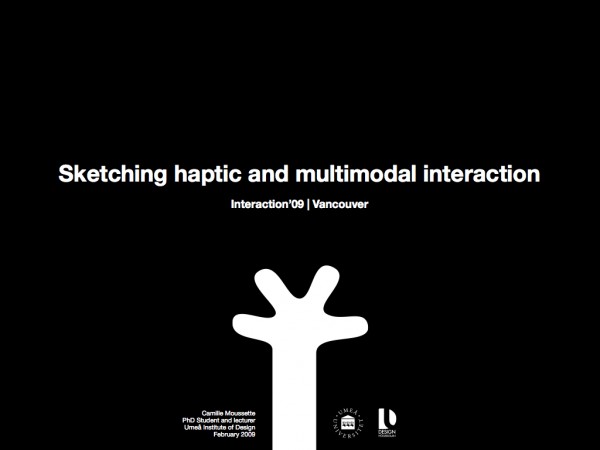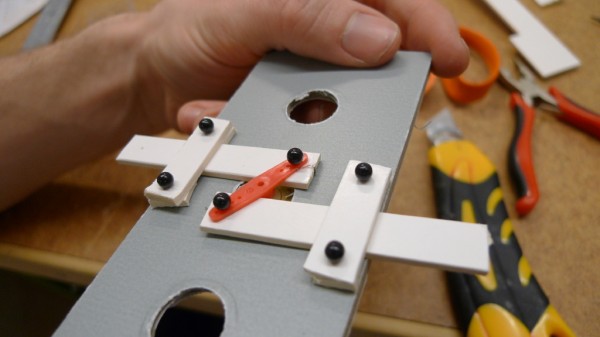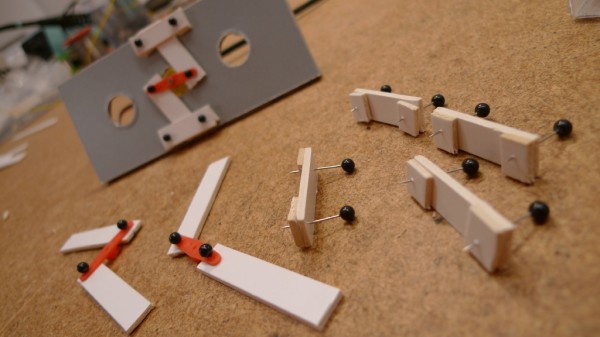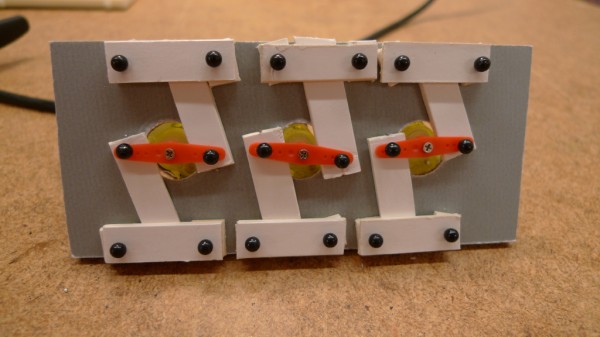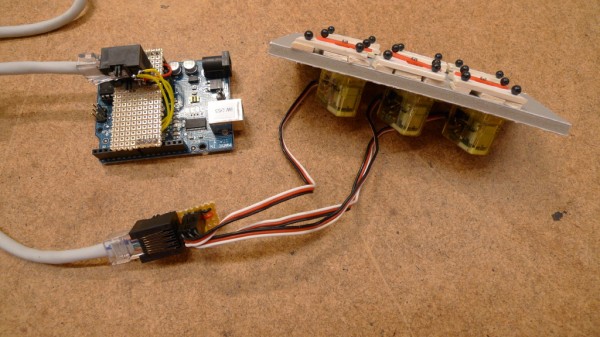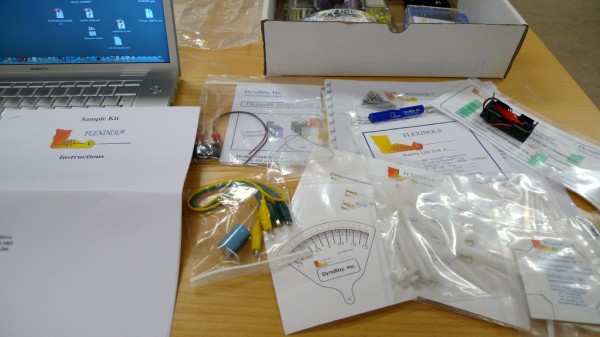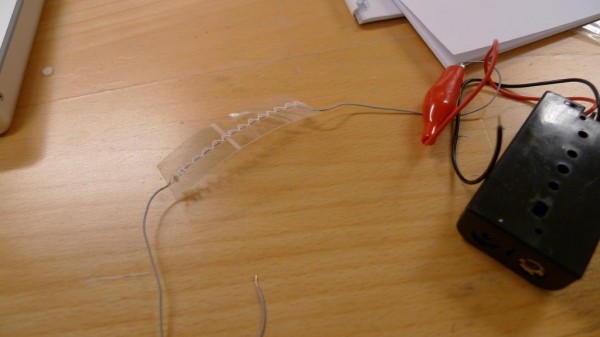CRD seminar Citerna
coming soon…
SIDeR’09 notes
coming soon…
CHI’09 notes
coming soon…
Symposium Split notes
CRD seminar Luleå
CRD seminar Luleå
March 9-11 2009, Luleå, Sweden
Gender and Design
The latest CRD research school meeting took place up north in Luleå at the Luleå Tekniska Universitet (LTU). The theme for the seminar was Gender and Design and I have to say I really enjoyed the event. I couldn’t understand all of the deep discussions during the three days, but I understood quite a bit, enough at least to find the different issues at hand very interesting.
The event took place at LTU’s DesignLab, part of the Work and Occupational Studies (Arbetsvetenskap) department. We had the chance to visit their nice facilities (including the nice acoustic rooms and an elaborate driving simulator). It was also interesting to learn and discover their Industrial Design Engineering program. They have quite a lot of students attending this education and the projets we could see looked different from what you expect from an Engineering school. This program seems to seat directly at the meeting point of Industrial Design and Production Engineering. Quite technical, but very interesting, really.
The first presentation from Janne Johansson was a truly interesting historical review of the Work and Occupational studies field. He presented the different roots and important works that led to the current situation we have today in this domain. Sweden and Scandinavia were precursors in many aspects, and it was nice to get this historical perspective.
During the following days, many presenters took the stage and revealed their work/research related to Gender and Design. I never realized that so much gender-specific are present in our day-to-day life and the objects/services surrounding us. We you stop and think about it, it’s everywhere, and kind of scary actually. And I don’t think we can avoid it really. We are all humans and member of one gender. Females and males are different in many ways, but we are naturally alike in other ways: we all social creatures that need to sleep, eat, interact with the world. Our value system is particularly culture-dependant and it affects greatly how we relate to gender-specific issues. Designers play an even bigger role as their “job” is to materialize, concretize, fulfill user’s needs and wishes. Bits and atoms are shaped and assemble according to a strange mix of personal values (or client’s ones) and technical possibilites. It is inevitable that gender-specific characteristics are present in designers’ works, both consciously and unconsciously.
Marcus Jahnke, from HDK/Göteborgs presented his work and publication FormgivningNormgivning. It contains fine examples of gender issues in relation to design, both from a critical perspective (discursive design he calls it) and from a proactive perspective. Nothing revolutionary, but definitely essential to explore/consider/reflect upon in today’s design projects.
I have now many articles and documents to read about the field. I’ll definitely try to embrace this aspect in my own research (and teaching also).
Resources and links:
http://en.wikipedia.org/wiki/Gender_role
On gender and things: Reflections on an exhibition on gendered artifacts
Design and emotion: the experience of everyday things
By Deana McDonagh, Paul Hekkert, Jeroen van Erp, Diane Gyi
Ewa Gunnarson, article/page
TEI’09 notes and report
TEI’09 | Cambridge
February 16-18 2009, Cambridge, UK
http://tei-conf.org/
Tom Igoe, ITP
We are pretty good at making stuff, we have to get way better at unmaking stuff
Reware, firmware to recycle old devices like ipods, PDAs, etc
http://dev.eyebeam.org/projects/reware/wiki/Reware
Layers of information in a typical electronic device
-firmware state machine
-firmware high level code
-firmware assembly code
-firmware binary
-schematic
-net list
-board layout file
-bill of materials (BOM)
-components materials list
-chemical list
-assembly order
-drill files
-pick & place data
-assembly tool list
-supporting materials used in assembly
-supporting chemicals used in assembly
Not everything is needed for recycling. IP protection still possible
Consider trojan horses to get stuff in the popular imagination
We need to develop basic literacies: energy, materials, production, resources, legacy
Look for opportunities to use dead tech
Defaults to openness
Ylva Fernaeus, SICS
Programming by physical demonstration (ex. curlybot, topobo)
It can work, but sometimes it’s nice to have a bit of code
Conference report and impression
The conference opened with a keynote from Tom Igoe. He presented ideas about sustainability and unmaking things. He mentioned that information about production and materials should be shared more so the community and users can recycle, reuse and repurpose items. A lot of this information is not related to IP. As a corporation, you could/should choose what you want to share/open with the community.
Interaction’09: my presentation
Here is the presentation I gave in Vancouver for Interaction’09. I had only 20 minutes, looking back at it I think I tried to cram too much into that timeframe. Usually I’m not so nervous for talks, but this time it was a bit different. The crowd was really knowledgeable and in the end I was quite nervous to expose my ideas and work to this audience.
Abstract:
Our sensorial system is our interface to the world. It is trough and with our senses that we can perceive, reason and exchange with external systems, living or not. Our professional and personal activities are made of rich and complex sensorial experiences, spanning on different stimulus and modalities.
Up to now, the repertoire of input and output forms generally found in human-device interfaces have been usually centered on vision and to some extend audition. Despite decades of research and development, very few systems or devices today go beyond these two senses and truly offer rich multimodal interaction. Why is that so?
This presentation will explore the opportunities and challenges related to developing new multimodal interfaces specifically based on the touch sense. It will present various methods, techniques, tools and processes that interaction designers can use to assess, sketch, create and evaluate dynamic haptic and multimodal interfaces.
2009.Interaction09.Moussette.pdf [PDF, 35 MB]
Interaction’09 notes

Interaction’09 | Vancouver
February 5-8 2009, Vancouver, Canada
http://interaction09.ixda.org
Coverage of the event on the web:
Core77 & Johnny Holland Magazine
Workshop: Designing for Touch screens and Interactive Gestures
Bill DeRouchey and Dan Saffer
A 3 hour workshop to reflect on designing for touch interaction.
A quick intro on touch screens, technology, design considerations, deliverables, adaptive targets, etc.
First exercise is to design a space (6’x6′) to experience and buy music in a retail store.
Our group focuses on an avatar to bring back the “music dude who knows it all” that was very common in the pre-digital era.
We paper prototyped many touch interaction, and it’s not easy.
Second exercise invites us to elaborate on the presentation, communication and documentation of the (touch) system.
Simple workshop, maybe I was expecting too much out of it.
Check http://www.interactivegestures.com for touch and gesture resources
Keynote: Experiencing Sustainability, John Thackara
Similar insights and call to action from what I’ve seen before from M. Thackara. Nevertheless, he is capable of communicating his ideas across with great optimism. He explains the many “peaks” and how we will have to change to survive as a specie.
Hidden costs of a mobile phone: 500 kg of resources.
I read his book, In The Bubble, during my flight to Vancouver and it covers a lot of his talks. He talks about City Eco Lab at St-Étienne (I’ve seen and it is very inspiring and motivating indeed).
Go local and look/use/share what you have near you.
We don’t need to invent anything, it’s all already happening as we speak. Have to embrace it.
read more…
Cardboard poking trio
I’ve been thinking about this simple poking mechanism for over two years now, but I never actually spent the time to build it. Now it’s a thing of the past! I took 3-4 hours later yesterday and this morning to make this first iteration out of foamcore, cardboard, pins and hot glue. I used three Draganfly 9 Gram Sub Micro servos to actuate the linkage. The resulting force is amazingly high for such tiny (and weak) servos.
I used RJ-45 (network) plugs and cable for the wiring. It took a bit more time to build but I feel it’s nicer and more convenient in the long as I plan to test and swap output modules often while prototyping various alternatives. I still have to work on a proper sequencer for this. Now the very basic sequences are hard-coded in the Arduino sketch.
I’m really happy it works so well and that it took only four hours to build. Will it last long, problably not, but then it’s a good excuse to make an improved version, with 5 servos, add a flexible/bendable casing around or just try another genetic variation!
What it does: The servo rotates and the link bars are pushed outward. It should poke the user’s hand.
Build notes: Pins are sharp, be careful while piercing through foamcore.
Next step: Improve the package. Link to a decent sequencer/trigger system (recycle an old one from HAPI or build one from scratch, maybe with Processing/Blender). Plan a standardized RF-45 configuration for all my devices (when possible): same pins for Vcc, GND and PWM at least. Laser cut the panels. Make it stackable/modular?
An introduction to shape memory alloys
I just received my Flexinol Deluxe kit, a box full of samples and little experiments to discover the great world of shape memory alloys (SMA). I have been fiddling with this stuff before but I never got farther than the regular “amazing spring” setup: you stretch a spring beyond its point of deformation, then if you heat it up it goes back to its original shape quite vigorously!
The kit contains a mixture of stuff, cheap demos and gimmicks, but the nicest things in my opinion are the little leaflets that explain the qualities and characteristics of SMA. The text introduces the SMA, the strengths of this technology (compared to servos and solenoids) and some typical setups for how to use SMA properly and fully.
I won’t copy all the good text from the manual, but in short, SMAs rearrange their crystal structure and shrink (~4% for Flexinol) when heated to a specific transition temperature (wikipedia page). One common way to heat the alloy is to run an electrical current through it for a short time. The tiny wires can create relatively quite strong forces, silently and with lifelike movement. Over the years, I have seen some very clever usage of SMA for building actuated interfaces or devices. Ivan Poupyrev and Marcelo Coelho have the most interesting projects I’ve seen so far: Lumen, Sprout I/O, Shutters and Surflex. I have a lot of ideas I would like to try with SMAs: shape-morphing shells, shifting the center of mass in handheld devices, soft-haptic stimuli, etc.
Well, first things first. I have to start with the basics and learn how to harness the power of these floss-like space-age filaments.

